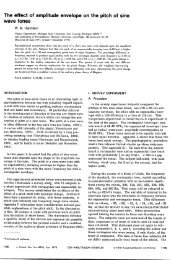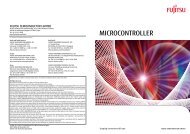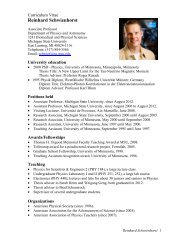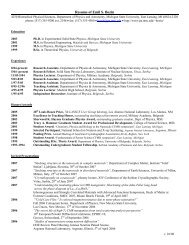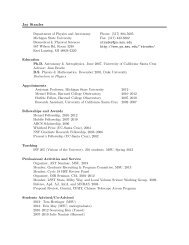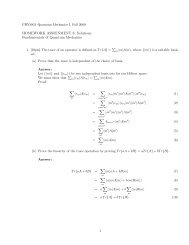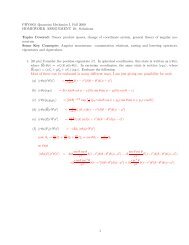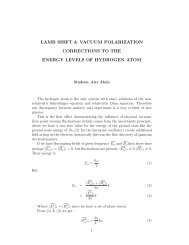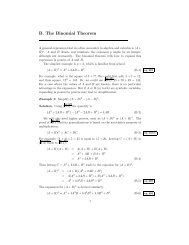HyperLynx SI GHz- Accurate, Easy-to-use, Multi-Gbps Solutions:0.qxd
HyperLynx SI GHz- Accurate, Easy-to-use, Multi-Gbps Solutions:0.qxd
HyperLynx SI GHz- Accurate, Easy-to-use, Multi-Gbps Solutions:0.qxd
Create successful ePaper yourself
Turn your PDF publications into a flip-book with our unique Google optimized e-Paper software.
White Paper<br />
ACCURATE, MULTI-GBPS SERIAL CHANNEL DE<strong>SI</strong>GN<br />
SOLUTIONS FOR THE ENTIRE DE<strong>SI</strong>GN TEAM<br />
July 2009<br />
ABSTRACT<br />
The design of high performance multi-<strong>Gbps</strong> channels inevitably requires facing new challenges.<br />
One possible approach is <strong>to</strong> attempt <strong>to</strong> blindly apply conservative layout guidelines that have been<br />
established by the success of previous designs or have been provided in the form of reference<br />
designs from an IC vendor. This methodology has merit, but will tend <strong>to</strong> result in designs that have<br />
mediocre performance and require unnecessarily expensive PCB materials and manufacturing<br />
processes and/or over-constrain the layout engineer placing components and routing the PCB. An<br />
alternative approach that will reduce cost and allow maximum performance is <strong>to</strong> develop knowledge of<br />
how physical design rules affect electrical performance so that appropriate tradeoffs can be applied.<br />
<strong>HyperLynx</strong> <strong>GHz</strong> provides an intuitive but powerful suite of <strong>to</strong>ols that allows every member of the high<br />
speed serial channel design team <strong>to</strong> participate in creating the highest quality design while minimizing<br />
manufacturing costs. <strong>HyperLynx</strong> <strong>GHz</strong> also provides the post layout analysis <strong>to</strong>ols that allow the team<br />
<strong>to</strong> ensure design goals have been met and that the product will operate reliably under field conditions.<br />
This document describes of the advantages of deploying <strong>HyperLynx</strong> <strong>to</strong> meet the increasingly complex<br />
challenges of high speed channel design. An overview is provided of the advanced analysis<br />
technology. Finally two case studies are presented exploring the sensitivity of channel design <strong>to</strong> two<br />
design trade-offs: via back-drilling and trace length imbalance.<br />
Author:<br />
Ian C. Dodd<br />
Men<strong>to</strong>r Graphics Corporation<br />
8005 SW Boeckman Road<br />
Wilsonville, OR 97070 USA<br />
Phone: +1 800-592-2210 or +1 503-685-7000<br />
www.men<strong>to</strong>r.com/pcb
THE HYPERLYNX PRODUCT FAMILY<br />
The <strong>HyperLynx</strong> product family provides comprehensive, easy <strong>to</strong> <strong>use</strong> solutions <strong>to</strong> <strong>to</strong>day’s high speed PCB<br />
analysis challenges. These solutions provide the flexibility and accuracy <strong>to</strong> meet the needs of whole electronic<br />
design team including: electrical design engineers, signal integrity engineers, thermal and emc management<br />
specialists.<br />
<strong>HyperLynx</strong> Signal and Power Integrity<br />
High-speed signal and power integrity analysis<br />
at circuit, behavioral and system levels in both<br />
the time and frequency domains<br />
<strong>HyperLynx</strong> Thermal<br />
Analyze board level thermal problems<br />
throughout the design cycle<br />
<strong>HyperLynx</strong> EMI<br />
Check PCBs for incorrect or dangerous routing<br />
structures that ca<strong>use</strong> EMI problems<br />
<strong>HyperLynx</strong> Analog/Mixed Signal<br />
Board-level analog circuit simulation integrated<br />
in<strong>to</strong> the DxDesigner environment<br />
www.men<strong>to</strong>r.com/pcb<br />
1
HYPERLYNX <strong>SI</strong> GHZ<br />
The <strong>HyperLynx</strong> product suite from Men<strong>to</strong>r Graphics<br />
leads the market in mainstream signal integrity <strong>to</strong>ols<br />
beca<strong>use</strong> of its intuitive and easy <strong>to</strong> <strong>use</strong> interface<br />
combined with its accurate and robust simulation<br />
technology. The <strong>HyperLynx</strong> <strong>SI</strong> <strong>GHz</strong> package offers<br />
numerous capabilities specific <strong>to</strong> high performance<br />
memory and multi-<strong>Gbps</strong> serial channel analysis.<br />
<strong>HyperLynx</strong> <strong>SI</strong> <strong>GHz</strong> includes the <strong>to</strong>ols needed <strong>to</strong> meet your current and future<br />
multi-<strong>Gbps</strong> memory and serial channel design challenges<br />
<strong>HyperLynx</strong> <strong>SI</strong> <strong>GHz</strong> applications include the design<br />
and post layout validation of high performance<br />
synchronous logic channels, source-synchronous<br />
memory b<strong>use</strong>s including DDR2 and DDR3 and all<br />
popular multi-<strong>Gbps</strong><br />
serial channels.<br />
• Consumer Audio/Video — high definition video<br />
(HDMI)<br />
• Computing — I/O b<strong>use</strong>s (Hyper Transport, PCEe),<br />
disk drive (SATA), external peripheral (USB)<br />
• Telecommunications — Fibre Channel, Infiniband<br />
and 10 Gigabit Ethernet<br />
• Mobile phones — display (MIPI) and camera<br />
(SMIA) interfaces.<br />
<strong>HyperLynx</strong> <strong>SI</strong> <strong>GHz</strong> provides the depth of technology<br />
needed <strong>to</strong> analyze the next<br />
generation of high<br />
performance serial<br />
channels. The FastEye<br />
<strong>to</strong>ol provides a rich<br />
environment for linear<br />
channel analysis and<br />
statistical post processing<br />
of bit error rate<br />
information. The<br />
Eldo/ADVance MS<br />
simula<strong>to</strong>r uniquely offers<br />
an efficient single kernel<br />
circuit and system level<br />
analysis capability. This provides the flexibility <strong>to</strong><br />
accurately analyze complex behaviors including driver<br />
non-linearity due <strong>to</strong> output saturation, advanced<br />
equalization or complex clock/data recovery.<br />
HYPERLYNX <strong>SI</strong><br />
GHZ HIGH SPEED<br />
<strong>HyperLynx</strong> <strong>SI</strong> <strong>GHz</strong><br />
provides the <strong>to</strong>ols<br />
needed <strong>to</strong> create and<br />
validate designs<br />
incorporating the high<br />
speed serial channel<br />
standards that are now<br />
established in every<br />
segment of the<br />
<strong>HyperLynx</strong> <strong>SI</strong> <strong>GHz</strong> pre- and post-layout views of an SATA high speed serial channel<br />
electronics industry:<br />
2 www.men<strong>to</strong>r.com/pcb
A single, integrated environment is provided for the<br />
<strong>HyperLynx</strong> <strong>SI</strong> <strong>GHz</strong> and <strong>HyperLynx</strong> Power Integrity<br />
(PI) <strong>to</strong>ol suites. The combined power of the two <strong>to</strong>ol<br />
suites can be <strong>use</strong>d <strong>to</strong> investigate the complexities<br />
introduced when multi-<strong>Gbps</strong> channels are subject <strong>to</strong><br />
noisy planes and non-ideal return paths. Common<br />
phenomena that can be investigated include:<br />
• Jitter introduced in<strong>to</strong> multi-<strong>Gbps</strong> channels when<br />
differential trace layout asymmetries convert<br />
common mode noise in<strong>to</strong> differential noise.<br />
• Characterization of coupled via pairs with nonideal<br />
return paths.<br />
THE HYPERLYNX <strong>SI</strong> GHZ ADVANTAGE<br />
<strong>HyperLynx</strong> <strong>SI</strong> <strong>GHz</strong> offers numerous advantages for<br />
<strong>use</strong>rs. These are summarized here.<br />
HYPERLYNX INCREASES PRODUCTIVITY<br />
<strong>HyperLynx</strong> is industry renowned for its intuitive <strong>use</strong>r<br />
interface. This combined with powerful analysis<br />
features ensures increased productivity and faster time<br />
<strong>to</strong> market.<br />
The <strong>HyperLynx</strong> experience starts with a shorter<br />
learning period. Cus<strong>to</strong>mers report using the on-line<br />
tu<strong>to</strong>rial and examples <strong>to</strong> learn the basic skills needed<br />
<strong>to</strong> pro<strong>to</strong>type and analyze a representative high speed<br />
serial channel in one day or less.<br />
User interface wizards lead the <strong>use</strong>r through the steps<br />
needed <strong>to</strong> accurately set up the more advanced<br />
analysis features.<br />
The combination of ease of <strong>use</strong> and advanced analysis<br />
in <strong>HyperLynx</strong> <strong>SI</strong> <strong>GHz</strong> ensures that every member of<br />
the design team, including hardware design engineers,<br />
PCB designers and signal integrity specialists, can<br />
cooperate in using a single analysis environment.<br />
Using consistent analysis at every stage of the design<br />
process from concept through post-layout validation<br />
ensures fast reliable results.<br />
HYPERLYNX ENABLES OPTIMAL CHANNEL<br />
PERFORMANCE<br />
Thorough high speed channel analysis in <strong>HyperLynx</strong><br />
allows designs <strong>to</strong> be tuned for maximum performance<br />
while providing adequate safety margins <strong>to</strong><br />
accommodate component and manufacturing<br />
<strong>to</strong>lerances.<br />
Tuning includes the optimal choice of components<br />
including drivers, receivers, connec<strong>to</strong>rs and cables. It<br />
also includes the appropriate choice of interconnect<br />
characteristics including PCB stackup, trace widths,<br />
routing rules and the appropriate via design.<br />
<strong>HyperLynx</strong> LineSim provides a fast efficient virtual<br />
pro<strong>to</strong>typing environment <strong>to</strong> conduct pre-layout high<br />
speed channel design tuning. The results of tuning can<br />
be quickly appraised in both the time and frequency<br />
domains.<br />
<strong>HyperLynx</strong> BoardSim provides post-layout channel<br />
analysis <strong>to</strong> ensure layout compromises have not<br />
significantly impacted channel performance.<br />
HYPERLYNX INCREASES PRODUCT<br />
RELIABILITY<br />
The design of a reliable product requires the<br />
concerted effort of the whole design team. <strong>HyperLynx</strong><br />
<strong>SI</strong> <strong>GHz</strong> provides a powerful single high speed serial<br />
channel analysis environment that can be shared and<br />
unders<strong>to</strong>od by all members of the design team.<br />
Reliable channel design requires paying attention <strong>to</strong><br />
detail at every step of the design process. Virtual<br />
pro<strong>to</strong>typing in <strong>HyperLynx</strong> ensures the choice of<br />
components and layout guidelines that will meet and<br />
exceed channel design requirements. Post-layout<br />
channel validation allows the PCB designer and the<br />
design engineer <strong>to</strong> work as a team <strong>to</strong> meet the<br />
performance goals while minimizing the adverse<br />
effects on other aspects of the layout.<br />
www.men<strong>to</strong>r.com/pcb<br />
3
HYPERLYNX <strong>SI</strong> GHZ REDUCES PRODUCT<br />
COST<br />
Almost all high speed serial channel design choices<br />
involve a trade-off between performance and cost. Just<br />
the choice of PCB materials and technology requires<br />
complex tradeoffs including:<br />
• Consistency of physical dimensions and traces<br />
impedance<br />
• Roughness of trace surfaces.<br />
• Choice of through-hole, blind and buried or backdrilled<br />
vias<br />
• PCB stack-up design including choice of dielectric<br />
materials.<br />
<strong>HyperLynx</strong> virtual pro<strong>to</strong>types allow the engineer <strong>to</strong><br />
quantifiably determine the performance impact of each<br />
design choice. This <strong>to</strong>gether with material and process<br />
cost information allows the choice of<br />
design options that meet performance<br />
standards at minimum cost.<br />
Increased <strong>to</strong>ol utilization<br />
<strong>HyperLynx</strong> <strong>SI</strong> <strong>GHz</strong> provides value at every stage of<br />
the design process, from sandbox through post-layout<br />
reliability analysis.<br />
Depth of technology<br />
<strong>HyperLynx</strong> <strong>SI</strong> <strong>GHz</strong> provides the depth of technology<br />
<strong>to</strong> address established and future high speed serial<br />
channel challenges. The well established<br />
Eldo/ADVance MS simula<strong>to</strong>r distinguishes<br />
<strong>HyperLynx</strong> <strong>SI</strong> <strong>GHz</strong> as the only signal integrity <strong>to</strong>ol <strong>to</strong><br />
provide efficient single kernel, simultaneous circuit<br />
and system level simulation. The single kernel<br />
implementation avoids the major inter-process<br />
communication overhead incurred in alternate<br />
solutions. Eldo/ADVance MS is complemented by<br />
HYPERLYNX <strong>SI</strong> GHZ MINIMIZES<br />
OWNERSHIP COST<br />
<strong>HyperLynx</strong> <strong>SI</strong> <strong>GHz</strong> offers full solutions<br />
<strong>to</strong> the most challenging high speed<br />
serial channel problems while<br />
minimizing ownership cost and<br />
investment risk. <strong>HyperLynx</strong> minimizes<br />
ownership cost through:<br />
Reducing training and support costs<br />
<strong>HyperLynx</strong> <strong>SI</strong> <strong>GHz</strong> combines accurate<br />
multi-<strong>Gbps</strong> channel analysis in an<br />
intuitive environment that everyone can<br />
<strong>use</strong>. It can meet all the routine and<br />
advanced analysis needs of the design<br />
team without resorting <strong>to</strong> complicated<br />
point- solution <strong>to</strong>ols. <strong>HyperLynx</strong><br />
technology is all internally developed<br />
resulting in solid integration between<br />
modules and has the advantage of a single point of<br />
contact for training, support and licensing.<br />
<strong>HyperLynx</strong> <strong>SI</strong> <strong>GHz</strong> LineSim<br />
6.25 <strong>Gbps</strong> Serial Channel<br />
Example<br />
the FastEye linear channel analysis engine that can<br />
simulate channel response at speeds approaching a<br />
million bits per minute.<br />
4 www.men<strong>to</strong>r.com/pcb
HYPERLYNX VISUAL IBIS EDITOR<br />
The first and most widely adopted interactive IBIS edi<strong>to</strong>r.<br />
• IBIS creation wizard • IBIS file outline view • Initial switch time correction<br />
• IV, VT curve plotting • Interactive syntax correction • Removal of non-mono<strong>to</strong>nicity<br />
HYPERLYNX TOUCHSTONE AND FITTED POLE VIEWER<br />
A powerful S-parameter and complex pole residue file generation utility.<br />
• Single-ended and Differential S-parameter<br />
Plotting<br />
• Non-Causality detection & correction<br />
• S-parameter file conversion: differential,<br />
single- ended, Y, Z, complex pole residue<br />
• Non-Passivity detection & correction<br />
• Remove unneeded ports<br />
• Synthesize SPICE equivalent model<br />
HYPERLYNX LINE<strong>SI</strong>M INTERACTIVE TRANSMIS<strong>SI</strong>ON LINE EDITOR<br />
The LineSim Edi<strong>to</strong>r provides an intuitive Eldo/ADVance MS high speed serial channel virtual pro<strong>to</strong>typing<br />
environment. Applications include:<br />
• Up front sandbox viability analysis<br />
• Pre-layout solution space analysis and constraint generation<br />
• Post layout trouble shooting or reliability analysis.<br />
LineSim allows for flexible interactive time and frequency domain analysis of high speed serial channels. Analysis<br />
at multiple levels of abstraction is fully supported:<br />
• SPICE / circuit level channel analysis in the widely adopted Eldo simula<strong>to</strong>r<br />
• Linear channel analysis utilizing the <strong>HyperLynx</strong> FastEye Suite<br />
• Simultaneous non-linear circuit and system level simulation with Eldo / ADVance MS.<br />
Highlights of the LineSim Environment Include:<br />
• Highly intuitive <strong>use</strong>r interface with wizards guide the <strong>use</strong>r through advanced operations such as via design,<br />
DDR3 simulation and FastEye linear channel analysis<br />
• Interconnects specified by physical (layer, width etc) or electrical (Vp, Z0 & delay) views.<br />
• Parameter sweeping controlled through a centralized spreadsheet<br />
• Full support for transis<strong>to</strong>r level SPICE, IBIS, SPICE macro, and VHDL-AMS (analog-digital mixed mode)<br />
behavioral device modeling<br />
• <strong>Accurate</strong> modeling of individual and coupled via pairs<br />
• Robust efficient S-parameter support with causality and passivity enforcement<br />
• <strong>Accurate</strong>, causal trace modeling using frequency dependant multi-pole Debye modeling of dielectric loss.<br />
• Support for third party SPICE simula<strong>to</strong>rs.<br />
• Design kit support, including PCIe, SATA, Fibre Channel and FPGA partners.<br />
www.men<strong>to</strong>r.com/pcb<br />
5
<strong>HyperLynx</strong> LineSim <strong>SI</strong> <strong>GHz</strong> provides a<br />
comprehensive environment for high<br />
speed parallel and high speed serial<br />
channel analysis. LineSim also provides<br />
the interactive focus for the <strong>HyperLynx</strong><br />
Power Integrity (PI) Suite. The<br />
addition of <strong>HyperLynx</strong> PI allows the<br />
high speed serial channel analysis <strong>to</strong><br />
incorporate the effects of non-ideal<br />
power planes including plane noise and<br />
couple vias with non-ideal return paths.<br />
SATA HS Serial Channel Extracted from BoardSim<br />
POST-LAYOUT VERIFICATION<br />
HYPERLYNX BOARD<strong>SI</strong>M POST-LAYOUT<br />
<strong>SI</strong>GNAL INTEGRITY EDITOR<br />
The <strong>HyperLynx</strong> <strong>SI</strong> <strong>GHz</strong> BoardSim post-layout multiboard<br />
edi<strong>to</strong>r allows the easy import of single or multiboard<br />
layouts from Men<strong>to</strong>r Graphics Board Station,<br />
Expedition, or PADS PCB.<br />
PCB Designs can also be easily imported from many<br />
third part PCB layout edi<strong>to</strong>rs including Cadence<br />
Allegro, or Orcad, Zuken Visula or CR-5000 and<br />
Altium.<br />
Off-board channel elements such as connec<strong>to</strong>rs and<br />
cables can be quickly and easily added.<br />
<strong>HyperLynx</strong> <strong>SI</strong> <strong>GHz</strong> BoardSim provides for post-layout<br />
designs, the same powerful device modeling and high<br />
speed serial channel simulation features as are<br />
provided by LineSim pre-layout designs.<br />
LineSim virtual pro<strong>to</strong>types can be au<strong>to</strong>matically<br />
extracted from routed nets in BoardSim for the<br />
purposes of performance trouble shooting or reliability<br />
analysis.<br />
HYPERLYNX MULTI-GBPS ANALY<strong>SI</strong>S<br />
TECHNOLOGY<br />
HYPERLYNX FASTEYELINEAR CHANNEL<br />
ANALY<strong>SI</strong>S SOLUTIONS<br />
FastEyeprovides the fastest possible high speed serial<br />
channel analysis, typically simulating millions of<br />
transitions per minute.<br />
<strong>HyperLynx</strong> FastEyeis available from an intuitive <strong>use</strong>r<br />
interface wizard that allows the <strong>use</strong>r <strong>to</strong> go from a high<br />
speed channel design pro<strong>to</strong>type <strong>to</strong><br />
an (optionally worst case) eye<br />
diagram and BER results in<br />
minutes.<br />
<strong>HyperLynx</strong> <strong>SI</strong> <strong>GHz</strong> BoardSim<br />
Example of SATA high-speed serial channel layout<br />
Highlights of the FastEye Suite<br />
Include:<br />
• Deterministic and random jitter<br />
sources<br />
• Support for Linear FFE and nonlinear<br />
DFE equalization. Tap<br />
settings can be optionally<br />
au<strong>to</strong>matically optimized.<br />
6 www.men<strong>to</strong>r.com/pcb
• Patent pending technology au<strong>to</strong>matically calculates<br />
the worst case channel stimulus subject <strong>to</strong> the<br />
constraints of channel pro<strong>to</strong>col (e.g. 8bit/10bit<br />
encoding).<br />
• Au<strong>to</strong>matic detection of significant channel nonlinearity.<br />
• Analysis may be based on channel impulse or<br />
internally generated pole zero residue description.<br />
Pole-zero descriptions are compact without<br />
excluding critical low frequency resonance<br />
information.<br />
HYPERLYNX MULTI-GBPS ANALY<strong>SI</strong>S<br />
TECHNOLOGY<br />
HYPERLYNX FASTEYELINEAR CHANNEL<br />
ANALY<strong>SI</strong>S SOLUTIONS<br />
FastEyeprovides the fastest possible high speed serial<br />
channel analysis, typically simulating millions of<br />
transitions per minute. <strong>HyperLynx</strong> FastEyeis available<br />
from an intuitive <strong>use</strong>r interface wizard that allows the<br />
<strong>use</strong>r <strong>to</strong> go from a high speed channel design pro<strong>to</strong>type<br />
<strong>to</strong> an (optionally worst case) eye diagram and BER<br />
results in minutes.<br />
Highlights of the FastEye Suite Include:<br />
• Deterministic and random jitter sources<br />
• Support for Linear FFE and non-linear DFE<br />
equalization. Tap settings can be optionally<br />
au<strong>to</strong>matically optimized.<br />
• Patent pending technology au<strong>to</strong>matically calculates<br />
the worst case channel stimulus subject <strong>to</strong> the<br />
constraints of channel pro<strong>to</strong>col (e.g. 8bit/10bit<br />
encoding).<br />
• Au<strong>to</strong>matic detection of significant channel nonlinearity.<br />
• Analysis may be based on channel impulse or<br />
internally generated pole zero residue description.<br />
Pole-zero descriptions are compact without<br />
excluding critical low frequency resonance<br />
information.<br />
www.men<strong>to</strong>r.com/pcb<br />
7
HYPERLYNX MIXED CIRCUIT AND SYSTEM<br />
LEVEL SOLUTIONS<br />
<strong>HyperLynx</strong> mixed circuit and system level simulation<br />
provides the fastest possible analysis when drivers or<br />
receivers exhibit significant non-linearity.<br />
The Eldo/ADVance MS (ADMS) simulation engine<br />
provides <strong>HyperLynx</strong> <strong>GHz</strong> with the ability <strong>to</strong><br />
simultaneously conduct full non-linear circuit analysis<br />
and system level analog and digital behavioral<br />
analysis. The single kernel implementation ensures<br />
the highest simulation efficiency.<br />
Highlights of the Mixed Circuit and System Level<br />
Simulation technology include:<br />
• Advanced <strong>Multi</strong>-<strong>Gbps</strong> drivers can be modeled<br />
including the non-linear effects of transis<strong>to</strong>r output<br />
saturation. This is becoming increasingly common<br />
as transis<strong>to</strong>r geometries and supply voltages shrink.<br />
• Complex behavior e.g. driver asymmetry or warm<br />
up can be easily modeled.<br />
• Simulation of traditional transis<strong>to</strong>r level SPICE<br />
models.<br />
• Analog behavioral models e.g. IBIS, SPICE macro<br />
or analog VHDL add few elements <strong>to</strong> the circuit<br />
simulation matrix so typically simulate 10-100X<br />
faster than transis<strong>to</strong>r level equivalents.<br />
• Complex pole fitting technology ensures fast,<br />
reliable and accurate interconnect modeling (with<br />
causality and passivity enforcement).<br />
• Digital behavioral models e.g. digital VHDL or ‘C’<br />
language are directly evaluated in an event driven<br />
digital simulation module. Complex digital driver<br />
and receiver modules, e.g. clock multipliers,<br />
pro<strong>to</strong>col encoding, filtering and clock/data recovery<br />
are efficient processed. (Simulating these elements<br />
in an analog circuit simula<strong>to</strong>r would be impossibly<br />
inefficient).<br />
8 www.men<strong>to</strong>r.com/pcb
CASE STUDY: IS BACK-DRILLING OF VIAS<br />
NECESSARY AT 6.25GBPS?<br />
The design of high performance multi-<strong>Gbps</strong> channels<br />
inevitably requires facing new challenges. One<br />
possible approach is <strong>to</strong> attempt <strong>to</strong> <strong>use</strong> blindly apply set<br />
of conservative layout guidelines that have been<br />
established by the success of previous designs or have<br />
been provided in the form of reference designs from<br />
an IC vendor. This methodology has merit, but will<br />
tend <strong>to</strong> result in designs that have mediocre<br />
performance and require un-necessity expensive PCB<br />
materials and manufacturing processes and/or overconstrain<br />
the layout engineer placing components and<br />
affect electrical behavior. The virtual pro<strong>to</strong>type for a<br />
the 6.25<strong>Gbps</strong> serial channel <strong>to</strong> be <strong>use</strong>d in this case<br />
study is shown.<br />
The example is representative of a system board with a<br />
plug in card. The relatively short BGA breakout and<br />
surface mount connec<strong>to</strong>r coupling traces have been<br />
implemented as micro-strip on the <strong>to</strong>p surface of the<br />
PCB. The majority of the channel has been<br />
implemented as strip-line on the first inner signal<br />
layer. This minimizes EMC and cross-talk between the<br />
channel and its neighboring nets. The Vcc plane<br />
between the two routing layers, provides the critical<br />
high frequency return path.<br />
LineSim 6.25 <strong>Gbps</strong> Channel Example<br />
routing the PCB. An alternative approach that will<br />
reduce cost and allow maximum performance is <strong>to</strong><br />
develop knowledge of how physical design rules affect<br />
electrical performance so that appropriate tradeoffs can<br />
be applied.<br />
<strong>HyperLynx</strong> <strong>SI</strong> <strong>GHz</strong> LineSim provides an efficient<br />
environment in which virtual pro<strong>to</strong>types can be created<br />
<strong>to</strong> gain knowledge of how physical design variations<br />
This design requires vias. Conservative design<br />
practices would require these vias <strong>to</strong> be implemented<br />
using blind vias or as back-drilled through hole vias.<br />
In this case study we will look at whether using plain<br />
through-hole vias will significantly affect channel<br />
performance.<br />
www.men<strong>to</strong>r.com/pcb<br />
9
Through hole via models with and without backdrilling<br />
were created in using the coupled via wizard.<br />
The two via designs are shown in below:<br />
<strong>HyperLynx</strong> Via Visualizer<br />
To fully understand the influence of back-drilling<br />
vias, it is necessary <strong>to</strong> look at its electrical effect in<br />
both the frequency and time domains.<br />
Frequency domain channel descriptions are created in<br />
LineSim utilizing the well established Eldo/ADVance<br />
MS simula<strong>to</strong>r and viewed using the <strong>HyperLynx</strong><br />
Touchs<strong>to</strong>ne and Fitted Poles Viewer. Plots of<br />
differential forward insertion loss versus frequency<br />
and common mode <strong>to</strong> differential mode conversion<br />
versus frequency for the<br />
channel with and without via<br />
back-drilling are shown below:<br />
The differential insertion loss<br />
plot shows that the channel<br />
with through-hole vias has<br />
substantial propagation losses.<br />
The channel with through-hole<br />
vias is free from significant<br />
resonances which could<br />
adversely affect channel reliability and make the<br />
results of time domain analysis sensitive <strong>to</strong> small<br />
changes in the fundamental frequency of the stimulus.<br />
The plot for the channel with back-drilled vias shows a<br />
decrease in propagation loss, but this decrease is not<br />
substantial. As might be expected, it is also free from<br />
significant resonances.<br />
Frequency Domain Effect of Via Back Drilling at 6.25 <strong>Gbps</strong><br />
10 www.men<strong>to</strong>r.com/pcb
FastEye Analysis of 6.25 <strong>Gbps</strong> Channel<br />
Worst-case 8b10b constrained stimulus, back-drilled vias and 2-tap FFE equalizer<br />
The common mode <strong>to</strong> differential mode plots shows<br />
that both versions of the channel are highly insensitive<br />
<strong>to</strong> common mode noise. This would be expected since<br />
the differential interconnect in this example is highly<br />
symmetric.<br />
In this example all time domain results were generated<br />
in a matter of minutes using the FastEyelinear channel<br />
analysis <strong>to</strong>ol. The figure on this page shows the highly<br />
intuitive FastEyemulti-step wizard <strong>to</strong>gether with a<br />
selection of analysis results.<br />
In the FastEyeanalysis, the channel pro<strong>to</strong>col was<br />
specified as using 8b10b encoding. This allows<br />
FastEye<strong>to</strong> calculate the worst case stimulus that is<br />
consistent with the pro<strong>to</strong>col (patent pending). In the<br />
example analysis, the worst case stimulus for the<br />
channel, with and without back-drilling of vias was<br />
<strong>use</strong>d <strong>to</strong> create the worst case eye diagrams.<br />
FastEyesupports the modeling and optimization<br />
common forms of transmitter and receiver equalization.<br />
Worst case eye measurements were made without<br />
equalization and with an optimal 2 tap FFE equalizer.<br />
www.men<strong>to</strong>r.com/pcb<br />
11
The results obtained are shown below:<br />
No Equalization<br />
Optimal 2-tap FFE Equalization<br />
Eye Height Eye Width Eye Height Eye Width<br />
Back-drilled vias 180 mV 98 ps (61% UI) 438 mV 145 ps (91% UI)<br />
Through-hole vias 139 mV 88 ps (55%UI) 393 mV 135 ps (84% UI)<br />
An analysis of the FastEyesimulation results indicate<br />
that, in this example, leaving the stub on the throughhole<br />
vias:<br />
• Does not introduce significant resonances at the<br />
signaling frequency.<br />
• Increases channel propagation loss.<br />
• Closes the eye at the receiver by a moderate<br />
(5-10%) amount.<br />
• Does not affect sensitivity <strong>to</strong> common mode<br />
(e.g. plane) noise.<br />
In order <strong>to</strong> make a definitive analysis of whether it is<br />
possible <strong>to</strong> omit the back-drilling of vias in the<br />
example layout further analysis is needed <strong>to</strong> study the<br />
sensitivity <strong>to</strong> other fac<strong>to</strong>rs that ca<strong>use</strong> performance<br />
degradation of the channel. In the next case study<br />
sensitivity <strong>to</strong> trace length imbalance between the two<br />
nets that make up a differential pair will be analyzed.<br />
CASE STUDY: HOW CLOSELY MUST TRACE<br />
LENGTHS BE MATCHED?<br />
Layout engineers are provided<br />
with complex constraints and<br />
design rules for each type of net<br />
in a layout. High frequency<br />
differential pairs have some of<br />
the most challenging<br />
constraints, often including<br />
length matching between the<br />
traces that make up the pair <strong>to</strong><br />
+/- mil. They are faced with the<br />
daunting task of meeting these<br />
requirements whilst minimizing<br />
production and material cost.<br />
Trade-offs are usually required, including routing<br />
multi-<strong>Gbps</strong> channels around obstacles such as areas of<br />
split planes which will not provide an adequate high<br />
frequency return path for the channels.<br />
Good layout practices e.g. using 45 degree corners and<br />
jogging around obstacles with turns in alternate<br />
directions can minimize imbalance in the electrical<br />
lengths of the legs of a differential pair. Practical<br />
designs will inevitably have some imbalance as can be<br />
seen in the layout shown previously in section<br />
describing BoardSim. This case study will show that<br />
<strong>HyperLynx</strong> LineSim provides an excellent<br />
environment <strong>to</strong> investigate the sensitivity of multi-<br />
<strong>Gbps</strong> channels <strong>to</strong> trace length imbalance. For<br />
simplicity the analysis will be done using the same<br />
LineSim example as was <strong>use</strong>d <strong>to</strong> investigate the effect<br />
of back-drilling-vias. Similar analysis can be carried<br />
out on routed nets first using BoardSim <strong>to</strong> assemble<br />
Adding Trace Length Imbalance in LineSim<br />
www.men<strong>to</strong>r.com/pcb<br />
12
the channel from its component layouts, cables and<br />
connec<strong>to</strong>rs. BoardSim can then be <strong>use</strong>d <strong>to</strong> export a<br />
LineSim virtual pro<strong>to</strong>type.<br />
As in the previous case study, <strong>to</strong> gain a full<br />
understanding of the sensitivity of high speed serial<br />
channel <strong>to</strong> a physical modification, it is necessary <strong>to</strong><br />
look at its electrical effect in both the frequency and<br />
time domains.<br />
Starting analysis in the frequency domain, differential<br />
S-parameter plots were created using a range of trace<br />
length imbalances from perfectly balanced <strong>to</strong> a 0.4<br />
inch imbalance. The differential mode insertion loss<br />
and common mode <strong>to</strong> differential mode conversion<br />
plots are shown.<br />
The differential insertion loss plots show that length<br />
imbalances as small as 0.1 inch ca<strong>use</strong> measureable<br />
increase in channel attenuation. Attenuation increases<br />
rapidly as the length imbalance increases due <strong>to</strong><br />
resonances. Significant low ‘Q’ resonances occur with<br />
length imbalances over 0.1 inches. For imbalances of<br />
0.3 inch or less the resonances are above the third<br />
harmonic of the channel frequency (3.125<strong>GHz</strong>) and<br />
may only have a minimal impact on channel<br />
performance.<br />
The common mode <strong>to</strong> differential mode conversion<br />
plot indicates that trace length imbalances have a<br />
dramatic effect on the conversion of common mode<br />
signals <strong>to</strong> differential mode signals. The maximum<br />
conversion ratio is plotted versus length imbalance in<br />
the graph below. It can be seen that a length imbalance<br />
of 0.2 inches ca<strong>use</strong>s close <strong>to</strong> 10% of the common<br />
mode noise from plane resonances and other sources<br />
<strong>to</strong> be converted in<strong>to</strong> differential noise.<br />
Conversion Ratio<br />
Common <strong>to</strong> Differential<br />
Mode Conversion<br />
Length Imbalance (inches)<br />
Common-<strong>to</strong>-Differential Mode Conversion<br />
Ratio vs. Length Imbalance (inches)<br />
<strong>HyperLynx</strong> FastEye linear<br />
channel analysis was <strong>use</strong>d <strong>to</strong><br />
characterize the channel in the<br />
time domain using a similar<br />
approach <strong>to</strong> that <strong>use</strong>d in the<br />
earlier case study. The results<br />
are plotted below for the range<br />
of imbalance lengths.<br />
The eye plot results for the<br />
example channel show that<br />
after equalization with a<br />
simple 2 tap FFE filter, trace<br />
length imbalance of 0.2 inches<br />
or less have a mildly adverse<br />
effect on eye opening (3-4%).<br />
13 www.men<strong>to</strong>r.com/pcb
The conclusions drawn from this case study include:<br />
• Trace length imbalances of 0.2 inches or less have a<br />
relatively minor direct effect on eye opening after<br />
simple equalization.<br />
• Trace length imbalances of as small as 0.1 inch can<br />
have a major indirect affect on eye opening by<br />
causing the conversion of common mode noise in<strong>to</strong><br />
differential mode noise. A PCB may have many<br />
sources of common mode noise including that<br />
induced by switching currents in<strong>to</strong> the power<br />
planes.<br />
CONCLU<strong>SI</strong>ON<br />
<strong>HyperLynx</strong> <strong>GHz</strong> provides the advantages needed <strong>to</strong> be<br />
successful in the challenging arena of high speed serial<br />
channel design. Its combination of intuitive <strong>use</strong>r<br />
interface, accuracy and powerful advanced analysis<br />
features allow teams <strong>to</strong> meet their goals:<br />
• Increased productivity<br />
• Lowest overall cost of ownership<br />
• Optimal channel performance<br />
• Increased product reliability<br />
• Reduced product cost<br />
www.men<strong>to</strong>r.com/pcb<br />
14
For more information, call us or visit: www.men<strong>to</strong>r.com/pcb<br />
Copyright 2009 Men<strong>to</strong>r Graphics Corporation. This document contains information that is proprietary <strong>to</strong> Men<strong>to</strong>r Graphics Corporation and may<br />
be duplicated in whole or in part by the original recipient for internal business purposes only, provided that this entire notice appears in all copies.<br />
In accepting this document, the recipient agrees <strong>to</strong> make every reasonable effort <strong>to</strong> prevent unauthorized <strong>use</strong> of this information.<br />
MF 7/09<br />
TECH8529-W



